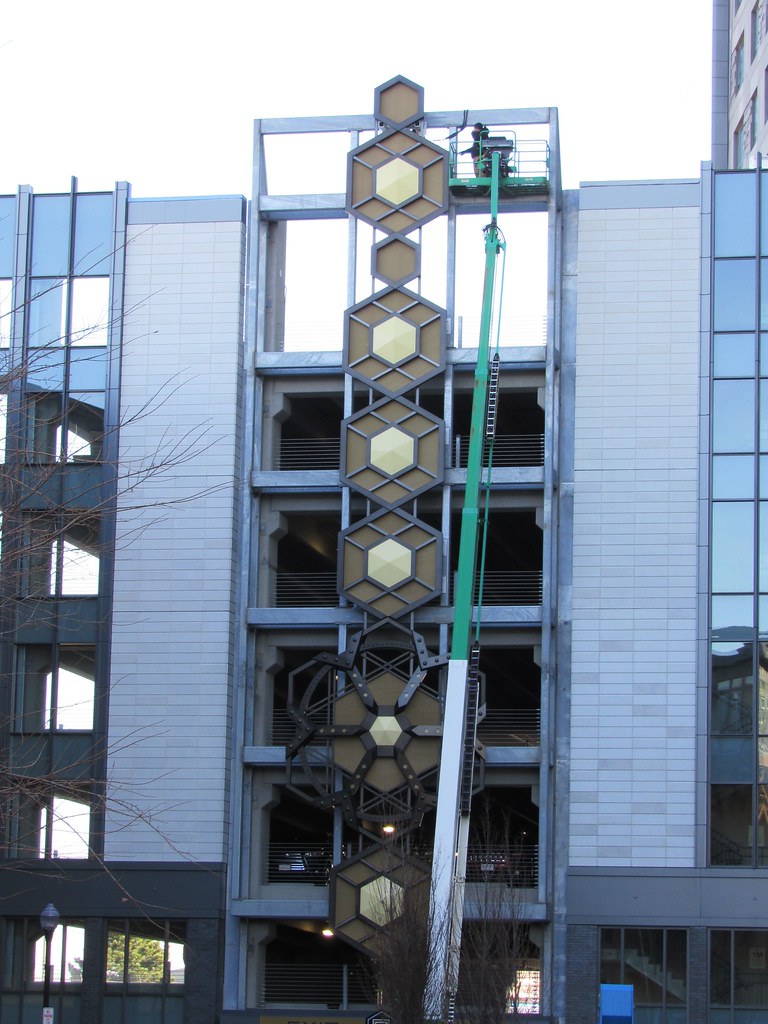The greatest part of this whole thing in my personal opinion, besides the varying facades that do a great job of differentiation and just looking good overall, is the way the garages are placed. Ive always wondered why places like Dubai or other cities with above ground garages don't do this. Here for the most part they place the garages in the middle and build low rise buildings around them on all sides. Thats the best way to hide them while still being able to have huge above ground garages. I never understood why Dubai just plops 10 story garages right on the side of the road. You can build towers on all four sides of a garage and low rises between them with a few entrances/exits and its completely hidden. Then on the roof you can have a huge common area. THAT is the way it should be done. You could do this literally anywhere where you need above ground parking and a lot of it but still want them hidden. Government center is another example where they are doing this as well. Theres no need for a garage to face a street...ever. Build the garage back from the street and put up condos against the street with ground level retail. You could replicate this in every city, everywhere, have tons and tons of parking, and great street level retail. Garages don't need to ruin the street level at all, just set them back from the street a bit, doesn't seem like too hard of a concept to understand but for some reason it seems like this is just being figured out.
These master planned cities popping up overseas need to get on this concept asap. To me Dubai seems like a mess besides that one road that circles around the Burj Dubai. If you were going to build a new city from scratch like Saudi Arabia is doing for example you can use superblocks or whatever size the parcel is between streets, build an entire garage the size of the block but set back from the street, and then as many towers or condos you want you just build along the street. Then in a few different places put a couple entrances and exits and your done. TONS of parking at literally every block, great street level, everyone wins. You wouldn't need a huge garage at every parcel because cities should be focused on all modes of transit but just as a proof of concept. However many you need use this model and everyone wins.
This means cars can park at literally whatever building they need to get to and not drive around for a few minutes clogging traffic, then you still build your rail transit for people who use that mode, bike lanes, etc and you have a well functioning city. They pretty much did this here for the most part so it would in a way be an assembly row but scaled up to an entire city with subways etc. To elaborate even further your could have open spaces running through the garages with an above ground "subway" that is still enclosed through the garages, with walls on both sides of the tracks, with bridges going over the streets to the next hole in the garage across the street. Now you have a subway with stations that can be climate controlled and doesn't need to have holes bored underground but also doesn't need to run down the middle of streets like an elevated rail. Its still hidden from view but above ground. On parcels without garages yet you just put the pieces up for the railway, and on parcels without garages it just goes behind the buildings like an el enclosed or not. I don't know how this wasn't figured out before.... Meanwhile we have cities like Dubai where there are parking garages at every tower but they're against the street and its looks like a huge mess. Somebody needs to take this concept and apply this to a masterplanned city. When you start from scratch these cities should be almost perfection...I mean you literally have a blank slate. They had a blank slate here and took full advantage of it. Take the best ideas from every city and apply them to yours. With regards to Dubai again the streets are also a mess, you can take the grid plan and combine it with this idea and make some encircling streets or whatever you want to do, take ides from different squares and courtyards around the world...etc and build something amazing. Anyways this is turning out great here and some of the concepts from Assembly should definitely be applied around the world.


